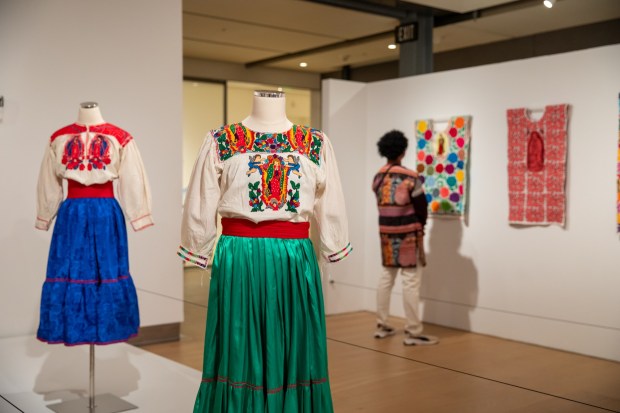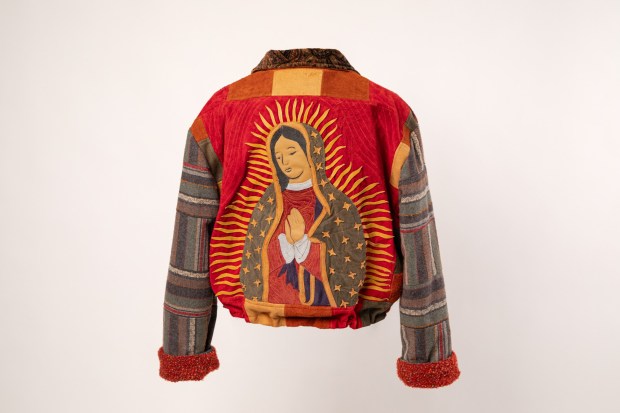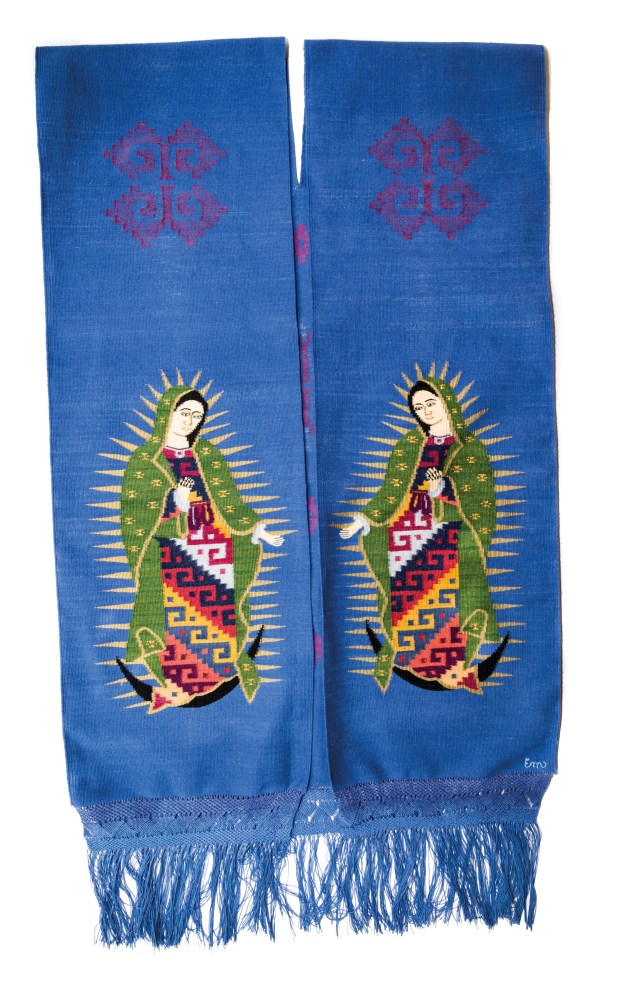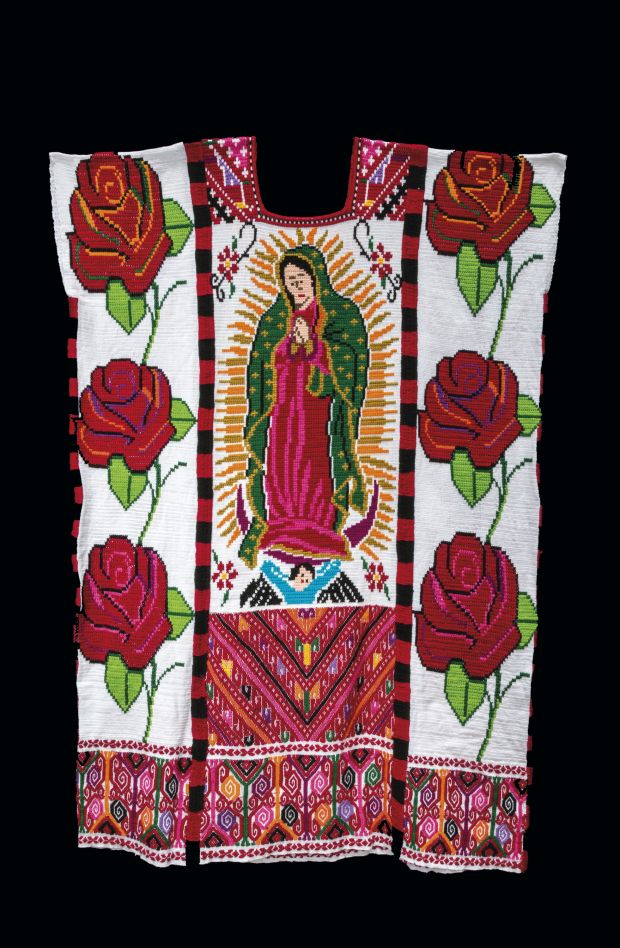In the Curator’s Words is an occasional series that takes a critical look at current exhibitions through the eyes of curators.
Our Lady of Guadalupe, also known as Virgin of Guadalupe, has a long history dating back to 1531, tied to four apparitions of the Virgin Mary to a peasant in Mexico.
Ariana Torres, assistant curator at Mingei International Museum in Balboa Park, talks about an exhibit titled “Fashioning an Icon: Virgin of Guadalupe Imagery in Textile Design,” which she curated.
 The “Fashioning an Icon: Virgin of Guadalupe Imagery in Textile Design” exhibit at the Mingei is on display through Sept. 7. (Mingei International Museum)
The “Fashioning an Icon: Virgin of Guadalupe Imagery in Textile Design” exhibit at the Mingei is on display through Sept. 7. (Mingei International Museum)
Q: The Our Lady of Guadalupe has long played a significant role in the fabric of San Diego’s arts and culture. Now, literally, there is an exhibit about this iconic cultural symbol as it’s represented on textiles. How did this exhibit come to be?
A: Textiles are central to the Virgin of Guadalupe’s story and an intriguing launching point to explore her image. Her most famous depiction is on a tilma (cloak-like garment), attributed to a 16th-century story of a Nahua man named Juan Diego. The story describes a series of apparitions, including one where she directs Juan Diego to collect roses in his garment along a Tepeyac hillside and bring them to church leaders as evidence of her existence. As the story goes, he unfurls his tilma and in addition to the roses, an impression of la Virgen appears on the fabric.
“Fashioning an Icon: Virgin of Guadalupe Imagery in Textile Design” expands from these fabric origins into how creative expression through wearable objects has made — or rather, fashioned — the Virgin of Guadalupe into the icon she is today. Her complicated and layered history has contributed to her multifaceted reception, and her image has grown beyond religion alone.
Being a folk art, craft and design museum, Mingei’s exhibition additionally focuses on the powerful intersection of craft, popular imagery and clothing in representing and retaining cultural heritage across generations and borders. I think this becomes especially important in our current political climate, where people of different cultural backgrounds face discrimination from institutions in power. These acts of creation and expression become moments of resistance when cultural existence and celebration are perceived as threats.
Q: What were your criteria when assembling such a vast collection of work by artists from the region?
A: The garments and accessories from Mexico are drawn from a private collection named “Rosas y Revelaciones” (compiled by a Oaxaca-based arts patron, Linda Hanna), which we were grateful to have access to as the base of our exhibition. Additionally, we knew that in order to tell a meaningful story of la Virgen’s image that reflects our San Diego-Tijuana community, it was crucial to include the work and stories of local artists.
 “Guadalajara” by San Diego artist Claudia Rodríguez-Biezunski (various upcycled fabrics, including suede, leather and cotton flannel, 2023) (Ron Kerner)
“Guadalajara” by San Diego artist Claudia Rodríguez-Biezunski (various upcycled fabrics, including suede, leather and cotton flannel, 2023) (Ron Kerner)
Q: With such an iconic symbol as the focal point of a big exhibition, how difficult was it to whittle down the collection to what’s currently on display?
A: Incredibly difficult! We wanted to show the range of styles of these amazing artists coming from different communities across Mexico — an area with long and varied traditions of textile crafts. Erasto (“Tito”) Mendoza Ruiz, Monica Díaz Martínez and Gabriela Sánchez are just three examples that we highlight in the exhibition who are masters of their respective crafts of loom weaving, palm weaving and jewelry design.
The local section, “An Icon Among Us,” also proved difficult to curate given the volume and variety of images of la Virgen seen in San Diego daily life. In the end, we featured three artists exploring the icon in different ways.
Local fashion designer Claudia Rodriguez-Biezunski runs her shop and brand, Sew Loka, out of her Barrio Logan studio. Her upcycled flannels and denim jackets adorned with the image of the Virgin of Guadalupe are well-known across the city. Claudia created the jacket, titled “Guadalajara,” as a tribute to her grandmother — part of a series of jackets reflecting facets of Claudia’s identity and upbringing.
I saw Diana Benavídez’s piece, “Even Guadalupe Needs a Break,” featured in Project BLANK’s 2024 “WORKING TITLE” exhibition, and it immediately moved me. Made of paper and plastic, the work is a continuation of Diana’s use of the piñata artistic technique and continues her commentary on women’s labor. It is also the only piece in our show representing the Virgin of Guadalupe’s own recognizable garment — a cloak that is both a product of labor and depicts, in the Virgin’s bodily absence, a rest from a period of labor.
Arianna Ytselle’s photography series project, “En Cada Rincón (“In Every Corner”),” is a window into the world outside our gallery, uplifting the artists and the community within which we exist, where la Virgen’s image is both an artistic inspiration and a touchpoint of cultural connection.
 Ruana by Erasto (Tito) Mendoza Ruiz from the collection of Linda Hanna (treadle loom woven with cotton thread, wool thread and metallic thread, macramé fringe, 21st century). (Judith Romero)
Ruana by Erasto (Tito) Mendoza Ruiz from the collection of Linda Hanna (treadle loom woven with cotton thread, wool thread and metallic thread, macramé fringe, 21st century). (Judith Romero)
‘Fashioning an Icon: Virgin of Guadalupe Imagery in Textile Design’
When: 10 a.m. to 5 p.m. Tuesdays-Sundays, through Sept. 7 (museum stays open until 8 p.m. on Fridays)
Where: Mingei International Museum, 1439 El Prado, Balboa Park
Tickets: $5 admission on “Summer Fridays” from 5 to 8 p.m. Regular admission: Adults $15; seniors 65 and over $10; educators, students and military with I.D. $10; members and youth 17 and under free.
Online: mingei.org
 Huipil by Rosa Elvia Leyva Antonio from the collection of Linda Hanna (woven cotton thread, embroidered with cotton thread, satin, 21st century) (Judith Romero)
Huipil by Rosa Elvia Leyva Antonio from the collection of Linda Hanna (woven cotton thread, embroidered with cotton thread, satin, 21st century) (Judith Romero)
Originally Published: July 13, 2025 at 5:00 AM PDT